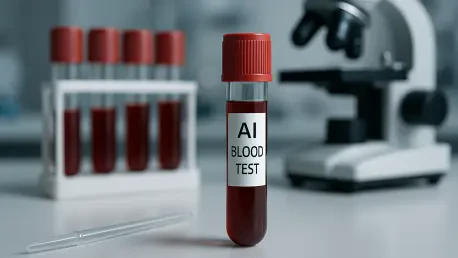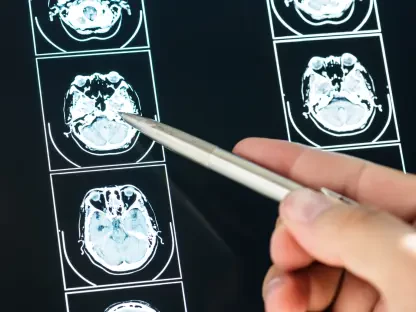Imagine a world where a single drop of blood could unlock the mysteries of how well someone is aging, offering a personalized roadmap to better health, and this isn’t a distant dream but a reality taking shape through groundbreaking research that harnesses artificial intelligence (AI) to analyze blood samples. Led by Wolfram Weckwerth from the University of Vienna and Nankai University, this cutting-edge study merges metabolomics—the science of small molecules in the body—with powerful machine learning tools. The result is a transformative approach to understanding aging, revealing how physical activity shapes health at a molecular level. By identifying specific biomarkers in blood, scientists can now peer into the body’s aging process with unprecedented precision, opening doors to tailored health strategies for older adults. What makes this even more compelling is the potential link between these markers and cognitive well-being, hinting at broader benefits. This research marks a pivotal step toward redefining how aging is monitored and managed.
Revolutionizing Aging with AI and Blood Tests
Decoding the Molecular Map of Aging
The integration of AI with metabolomics is reshaping the landscape of aging research, offering a fresh lens through which to view the body’s internal clock. This innovative method analyzes blood samples to detect molecular signatures that reflect how aging unfolds at a cellular level. Unlike traditional assessments that rely on visible signs or subjective reports, this approach digs deeper, pinpointing small molecules known as metabolites that signal health status. The study’s use of machine learning amplifies this process by sifting through complex biological data to uncover patterns invisible to the human eye. These patterns reveal not just chronological age but biological age—how well the body is holding up over time. Such precision could transform preventive healthcare by identifying risks early and suggesting interventions. The focus on older adults in this research underscores the urgency of addressing age-related decline, while the technology promises insights that could benefit people at any stage of life.
Beyond the technical prowess, this research highlights the profound impact of lifestyle on aging at a molecular level. Physical activity, long known to boost overall health, emerges as a key player in altering blood chemistry for the better. The study shows that regular exercise influences specific metabolites tied to vitality, suggesting that staying active can slow the wear and tear of aging. Machine learning models used in the analysis achieve remarkable accuracy in distinguishing between active and less active individuals, proving that blood tests can serve as a reliable gauge of fitness. This isn’t merely about confirming what’s already known about exercise; it’s about understanding the intricate biochemical shifts that occur. By mapping these molecular changes, researchers are building a foundation for personalized health plans that could optimize aging. The implications are vast, potentially shifting how medical professionals approach everything from routine checkups to chronic disease prevention.
A striking aspect of this study is the sheer depth of data it handles, merging biological insights with computational power to decode aging’s complexity. The team analyzed thousands of blood samples to identify consistent biomarkers linked to physical health, a feat made possible only through AI’s ability to process vast datasets. This isn’t just about finding a single indicator but about constructing a comprehensive picture of how various molecules interact as the body ages. The research also emphasizes metabolic pathways—networks of chemical reactions—that are influenced by external factors like exercise. These pathways offer clues about why some individuals age more gracefully than others. By focusing on these molecular maps, the study moves beyond surface-level observations to reveal the hidden mechanisms of aging. This approach could eventually lead to diagnostic tools that predict health trajectories years in advance, providing a proactive way to tackle age-related challenges before they become critical.
From Lab to Life: Practical Implications
The practical potential of AI-driven blood tests is where this research truly shines, promising a shift toward non-invasive, accessible health monitoring. Unlike invasive procedures or time-consuming physical assessments, a simple blood draw could soon provide a detailed snapshot of an individual’s aging profile. The study demonstrates a direct correlation between blood-based molecular signatures and real-world physical performance, such as walking speed or grip strength. This means that a routine test might one day inform doctors and patients alike about fitness levels without the need for extensive evaluations. Such a tool would be especially valuable for older adults, who often face mobility challenges that complicate traditional testing. The ease and precision of this method could make regular health tracking a standard part of medical care, empowering individuals to take charge of their aging journey with data-driven decisions.
Moreover, the implications of this technology extend into the realm of personalized healthcare, tailoring interventions to match unique biological needs. By identifying specific metabolites that reflect fitness and metabolic health, the research paves the way for customized recommendations—whether it’s adjusting exercise routines or dietary habits. The accuracy of AI models, which predict activity levels with over 91% reliability, suggests that these blood tests could become a cornerstone of preventive medicine. For healthcare providers, this offers a chance to move beyond one-size-fits-all solutions, instead crafting plans based on hard data from a patient’s own body. This level of personalization could be a game-changer, particularly for managing chronic conditions often associated with aging. As this technology evolves, it might integrate seamlessly into annual checkups, providing ongoing insights that help maintain vitality well into later years.
Uncovering Fitness Through Blood Markers
Physical Performance Meets Blood Chemistry
One of the most compelling findings from this research is the tight link between physical performance and blood chemistry, captured through innovative metrics. The team developed a “Body Activity Index” (BAI), a comprehensive measure combining factors like walking distance, chair-rise ability, handgrip strength, and balance to assess overall fitness. Alongside this, a “Metabolomics Index” was created, derived from blood concentrations of numerous small-molecule metabolites across hundreds of samples from older adults. The correlation between these two indices is striking, with statistical analysis showing a strong connection that confirms blood markers can mirror physical capabilities. This discovery validates the idea that a simple lab test can reflect tangible health outcomes, offering a non-invasive way to gauge how well someone is aging. For many, this could simplify health assessments, eliminating the need for extensive physical testing while still providing accurate insights.
This connection between blood and body performance isn’t just a scientific curiosity—it’s a stepping stone to redefining health monitoring. The ability to quantify fitness through a blood sample means that even subtle declines in physical ability could be detected early, long before they become apparent through traditional means. The research focused on older adults, a population often at risk for reduced mobility, making this finding particularly relevant. By establishing a direct link between measurable molecular profiles and everyday activities, the study suggests that routine blood tests could become as common as checking blood pressure. This approach also holds promise for tracking progress over time, allowing individuals and healthcare providers to see how lifestyle changes impact health at a cellular level. The precision of this method, backed by robust data, underscores its potential to become a staple in aging care, bridging the gap between abstract science and practical application.
Key Biomarkers and Metabolic Insights
Delving deeper into the molecular details, the study identifies specific metabolites as key indicators of fitness and active aging, with aspartate standing out as a dominant biomarker. Alongside aspartate, other molecules like proline, fructose, and citrate were flagged as significant predictors of physical activity levels, thanks to the use of advanced machine learning models such as Gradient Boosting Machines and XGBoost. These models, validated through rigorous testing, achieved impressive accuracy in distinguishing between active and less active individuals. Aspartate’s predictive importance, noted to be two to three times higher than other markers, highlights its critical role in signaling metabolic health. This finding isn’t just about naming a molecule; it’s about understanding how the body’s chemistry reflects lifestyle choices. Such biomarkers could eventually guide interventions, helping to fine-tune exercise or nutrition plans based on an individual’s unique blood profile.
To uncover the “why” behind these biomarkers, the research employed a novel modeling tool called COVRECON, which reconstructs metabolic networks to show how molecules interact. This analysis revealed that enzymes like aspartate aminotransferase (AST) and alanine aminotransferase (ALT), typically associated with liver function, play a central role in metabolic adaptability influenced by exercise. Active participants showed greater fluctuations in these enzyme levels over a six-month period compared to their less active counterparts, suggesting that physical activity enhances flexibility in liver and muscle metabolism. This insight into metabolic plasticity paints a vivid picture of how the body rewires itself in response to movement, even later in life. By mapping these biochemical pathways, the study provides a clearer understanding of how staying active can fundamentally alter internal processes, offering a molecular explanation for the benefits of exercise that could inform future health strategies.
Bridging Body and Brain Health
Exercise as a Shield for Mind and Muscle
The research takes an intriguing turn by exploring how physical fitness, as reflected in blood markers, might also safeguard cognitive health, creating a vital link between body and mind. Aspartate, identified as a key biomarker for physical vitality, doubles as a precursor to neurotransmitters in the brain, activating receptors crucial for learning and memory. This dual role suggests that exercise-induced changes in metabolism could bolster brain resilience, potentially offering protection against conditions like dementia or Alzheimer’s disease. Supporting evidence from separate studies indicates that imbalances in related enzymes during midlife correlate with heightened risks of cognitive decline. By showing how physical activity influences these molecular pathways, the research hints at a broader impact of staying active, one that extends beyond muscles to mental sharpness, inspiring a holistic view of health as people age.
This connection between physical and cognitive well-being amplifies the importance of accessible tools like AI-driven blood tests in promoting healthier aging. If a simple blood draw can reveal not just fitness levels but also potential protective effects on the brain, it could motivate more individuals to prioritize exercise as a lifelong habit. The study’s focus on metabolic markers offers a tangible way to measure these benefits, moving beyond vague advice to concrete data. For older adults, who often face both physical and mental health challenges, this dual benefit could be transformative, providing a clear incentive to maintain activity levels. The implications stretch into public health as well, suggesting that initiatives promoting exercise could have far-reaching effects on reducing age-related cognitive issues. As this technology advances, it might become a cornerstone of preventive care, encouraging a proactive approach to preserving both body and mind.
Future Horizons in Aging Research
Looking ahead, the insights from this study lay the groundwork for exciting advancements in how aging is understood and managed at a molecular level. The ability to predict physical activity levels with high accuracy through blood analysis signals a future where personalized health monitoring is the norm. This could lead to routine screenings that track biological aging alongside chronological age, offering early warnings about potential health declines. The emphasis on specific metabolites like aspartate also opens avenues for targeted research into supplements or therapies that mimic the effects of exercise on metabolism. Such innovations could be particularly impactful for those unable to engage in regular physical activity due to injury or disability, providing alternative ways to support healthy aging. The integration of AI ensures that these tools will only become more precise over time, refining the ability to tailor health strategies to individual needs.
Reflecting on the strides made, it’s evident that this research has already shifted the conversation around aging from passive observation to active intervention. The past focus on merely documenting age-related changes gave way to a proactive stance, as demonstrated by the detailed mapping of metabolic networks and their response to lifestyle factors. Years ago, the idea of a blood test revealing such intricate details about fitness and brain health seemed far-fetched, yet rigorous analysis and technological innovation brought it to fruition. Moving forward, the challenge lies in translating these findings into everyday tools—perhaps wearable devices paired with blood analysis apps—that make health insights accessible to all. Collaborations between scientists, clinicians, and tech developers will be key to scaling this technology, ensuring that the benefits of active aging reach diverse populations. Ultimately, the path ahead involves building on these discoveries to craft a future where aging is not just endured but optimized.









